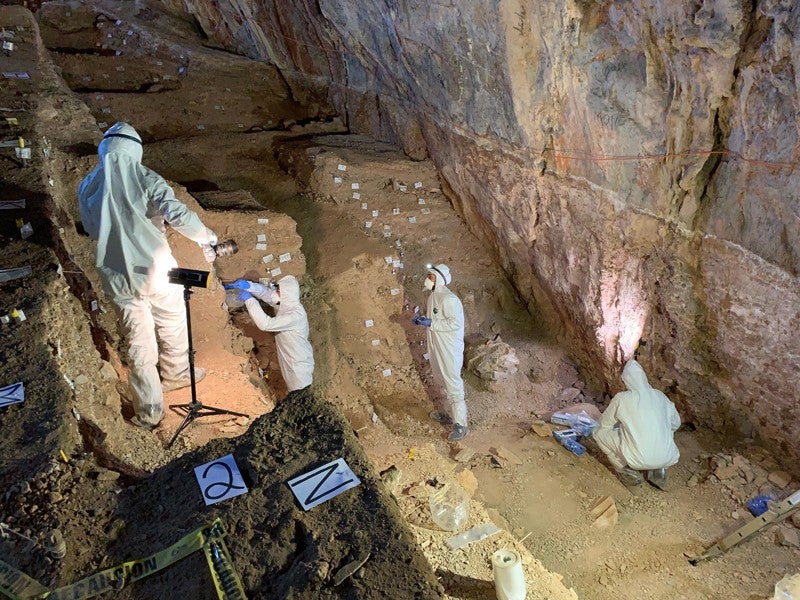Archaeologists excavating a cave in the mountains of central Mexico have unearthed evidence that people occupied the area more than 30,000 years ago—suggesting that humans arrived in North America at least 15,000 years earlier than thought.
The discovery, which includes hundreds of ancient stone tools, is backed up by a fresh statistical analysis that incorporates data from other sites. But the conclusion has stirred controversy among some researchers.
“When I see a claim being made that is so dramatic, then the evidence has to be there to substantiate the claim,” says archaeologist Kurt Rademaker at Michigan State University in East Lansing.
The first humans in the Americas came from East Asia, but when they began to arrive is hotly debated. Some researchers think that it could have been as early as 130,000 years ago, although most of the archaeological evidence supporting this theory is disputed. For instance, some of the stone artefacts are so simple that sceptics say they were probably produced by natural geological processes rather than by people. The mainstream view is that the peopling of the Americas began about 15,000 or 16,000 years ago—based on genetic evidence and artefacts found at sites including the 14,000-year-old Monte Verde II in Chile.
The latest discoveries, published on 22 July in Nature, question that consensus. Since 2012, a team led by Ciprian Ardelean at the Autonomous University of Zacatecas in Mexico has been excavating Chiquihuite Cave, which is 2,740 metres above sea level in the country’s Astillero Mountains. The researchers found almost 2,000 stone tools, 239 of which were embedded in layers of gravel that have been carbon dated to between 25,000 and 32,000 years old.
There are so few of these oldest tools that Ardelean thinks the site was visited only occasionally, perhaps used as a refuge every few decades, during particularly severe winters. At the height of the last ice age, 26,000 years ago, North America would have been a dangerous place. “There must have been horrible storms, hail, snow,” he says. He adds that the Chiquihuite Cave is well insulated and could have provided shelter to any humans who were around to witness the blizzards.
Troublesome data
The team makes a good case for ancient human occupation, says François Lanoë, an archaeologist and anthropologist at the University of Arizona in Tucson. But he adds that data from caves are “notoriously troublesome” to interpret. Stone tools might have been shifted into deeper layers by geological or biological activity—perhaps moved by burrowing animals—making them seem older than they really are.
That’s assuming they really are stone tools. “If an artefact is a stone tool, you see numerous chips removed from the edge,” says Rademaker. He sees no clear evidence of this in the images in the paper—a point echoed by archaeologist Ben Potter at Liaocheng University in China.
Ardelean admits that some of the tools might have shifted into lower layers, although he says the 239 oldest tools lie beneath an impenetrable layer of mud formed during the height of the last ice age, so they must be at least that old. He insists they are tools—in fact, he thinks some have telltale marks suggesting that they were made by novices learning from experts. “Somebody was teaching somebody else at this site,” he says.
Aside from the stone tools, the team found relatively little evidence of human presence. Geneticists led by Eske Willerslev at the University of Copenhagen searched for ancient human DNA in the cave dirt, but with no luck. “Of course, I was disappointed,” says Ardelean.
Early settlers
In a second study, also published in Nature, two of Ardelean’s co-authors—archaeologists Thomas Higham and Lorena Becerra-Valdivia at the University of Oxford, UK—combined the Chiquihuite Cave evidence with data from 41 other archaeological sites in North America and a region of eastern Siberia and western Alaska called Beringia, and built a statistical model of early human settlement. They concluded that people were present across North America much earlier than the accepted date of 15,000–16,000 years ago.
Some archaeologists think that it is time to take these ideas seriously. “The growing body of evidence for people in Beringia before 15,000 years ago renders their appearance in places like Mexico 20,000 or 30,000 years ago less surprising,” says John Hoffecker, an archaeologist at the University of Colorado Boulder.
Others disagree. Collins says Becerra-Valdivia and Higham assume that early sites such as Chiquihuite Cave and Bluefish Caves in Yukon, Canada, where artefacts have been dated to 24,000 years ago, offer unambiguous evidence of human activity. “This is far from the case,” he says.
Becerra-Valdivia accepts that evidence from most sites—with the exception of Monte Verde II—is disputed, but says that the analysis purposely omitted information from the most controversial sites, to make its case stronger.
If there were people in North America so early, it’s unclear what happened to them. “There continues to be no convincing genetic evidence of a pre-15,000-years-ago human presence in the Americas,” says geneticist David Reich at Harvard Medical School in Boston, Massachusetts
Ardelean says there is a simple reason why genetic studies suggest that humans spread across the Americas only relatively recently: early groups such as the one he thinks was present at Chiquihuite Cave didn’t survive to contribute to modern gene pools. “I definitely advocate for the idea of lost groups,” he says.
This article is reproduced with permission and was first published on July 22 2020.


